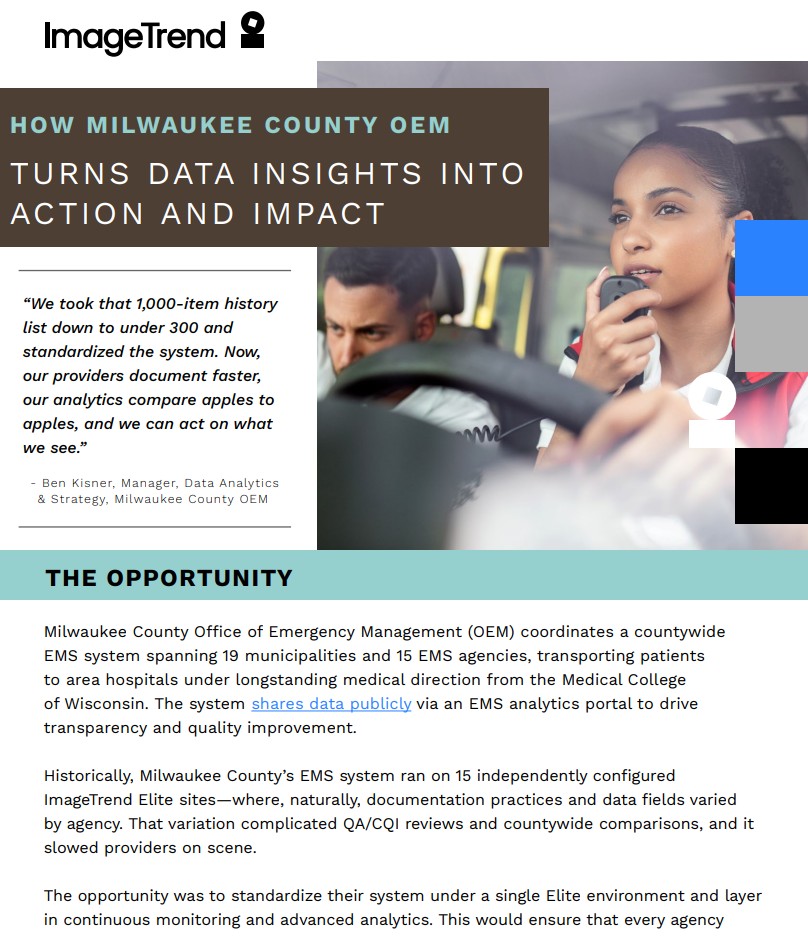The Opportunity
Milwaukee County Office of Emergency Management (OEM) coordinates a countywide EMS system spanning 19 municipalities and 15 EMS agencies, transporting patients to area hospitals under longstanding medical direction from the Medical College of Wisconsin.
The opportunity was to standardize their system under a single ImageTrend Elite environment and layer in continuous monitoring and advanced analytics. This would ensure that every agency could capture the same fields with the same definitions and rules, while enabling the county to move faster on clinical and operational priorities, and turn signals into action at county scale.
The Approach
- Milwaukee County standardized Elite Rescue with system-level validations and visibility rules, then added agency-level validation so individual agencies can layer their own checks on top of the county standard—providing local control without forcing everyone into a single “OEM form.” Working with agency liaisons, the team streamlined the Primary Impression list, reducing it from about 1,000 options to a smaller, standardized set. They also use presets for common call types (such as lift assist and canceled call) to streamline data entry. ImageTrend’s AI Assist is enabled, with a pilot planned at a smaller suburban agency to further reduce clicks and speed narratives.
- Milwaukee OEM is standing up Continuum monitors (e.g. for field blood administration) that notify leadership and medical direction immediately. For day-to-day views, the team primarily relies on internally built dashboards.
- Milwaukee County maintains an annual subscription to the External Data Mart, which feeds their Microsoft SQL Server environment. They use Power BI for visualization and join Elite data with EMS communications datasets (for example, STEMI and trauma alerts) to provide integrated decision support.
- biospatial is used for out-of-the-box overdose, stroke, STEMI, and respiratory surveillance. During the 2023 poor air-quality events, the OEM identified a persistent respiratory “hot spot” ZIP code for further study.
- ImageTrend’s Health Information Hub (HIH)—our ePCR-vendor-agnostic interoperability solution—is live with Children’s Hospital. OEM is receiving some outcome data into the External Data Mart and for clinician feedback, and it is working to onboard additional health systems.
The Outcome
Cleaner, faster Documentation—Plus Comparable Data
Consolidation combined with system-level rules removed
variation, reduced clicks, and enabled true countywide
comparisons in dashboards and QA/CQI reviews. For
example, STEMI identification is now “gamified” between
units. Using their internal QA dashboards, the OEM has
added a friendly competitive element around performance
on STEMI, so med units and fire departments can see how
they stack up against each other on that KPI.
Flood → Mold Remediation, Targeted by Data
After Milwaukee’s historic 2025 flood that caused roughly five billion gallons of sewage backup, OEM used the Social Vulnerability Index and respiratory-status data to prioritize ZIP codes for mold remediation and abatement. The goal was to prevent exacerbations of chronic conditions and reduce downstream emergency department burden.
Overdose Prevention: Data Driving Placement & Messaging
OEM’s overdose dashboards, which include drug combination insights (for example, fentanyl plus cocaine), guide Narcan placement and community education in partnership with OD PHAST (Overdose Public Health and Safety Team). County leaders report a year over-year decline in fatal overdoses, along with reduced naloxone administration by EMS. This public reporting aligns with the county’s broader data driven effort to decrease opioid deaths.
Operational Scale and Responsiveness
City responders performed approximately 65 to 70 water rescues during the flood period. OEM is exploring a lightweight disaster-impact capture—such as embedding a Survey123 URL in workflows—to augment situational awareness during routine calls and collect damage assessment information utilizing an existing workforce.
“We took that 1,000-item history list down to under 300 and standardized the system. Now, our providers document faster, our analytics compare apples to apples, and we can act on what we see.”
—Ben Kisner, Manager, Data Analytics & Strategy, Milwaukee County OEM
What’s Next?
Milwaukee OEM is tightening device data completeness. Internal dashboards now track the percentage of transported calls, and monthly reviews turn those numbers into targeted provider and agency feedback to raise compliance.
On the documentation and monitoring front, the team will pilot Elite’s AI Assist with a smaller suburban agency and then expand its use, while broadening Continuum monitors to capture more high-value clinical and operational events as they happen.
Interoperability is also growing. OEM plans to add more Health Information Hub hospital partners and clarify data-push triggers so clinician feedback arrives faster and outcomes flow reliably into the External Data Mart.
Finally, with richer outcome data, OEM will study trends in chronic conditions—such as asthma, CHF, diabetes, and sepsis—and correlate those findings with climate signals like air quality, temperature, and barometric pressure to anticipate risk and tailor
community education.

Related Resources


Tomorrow Won’t Look Like Today. Prepare for What’s Next.
See the bigger picture and confidently face the challenges ahead with our industry-leading solutions.



